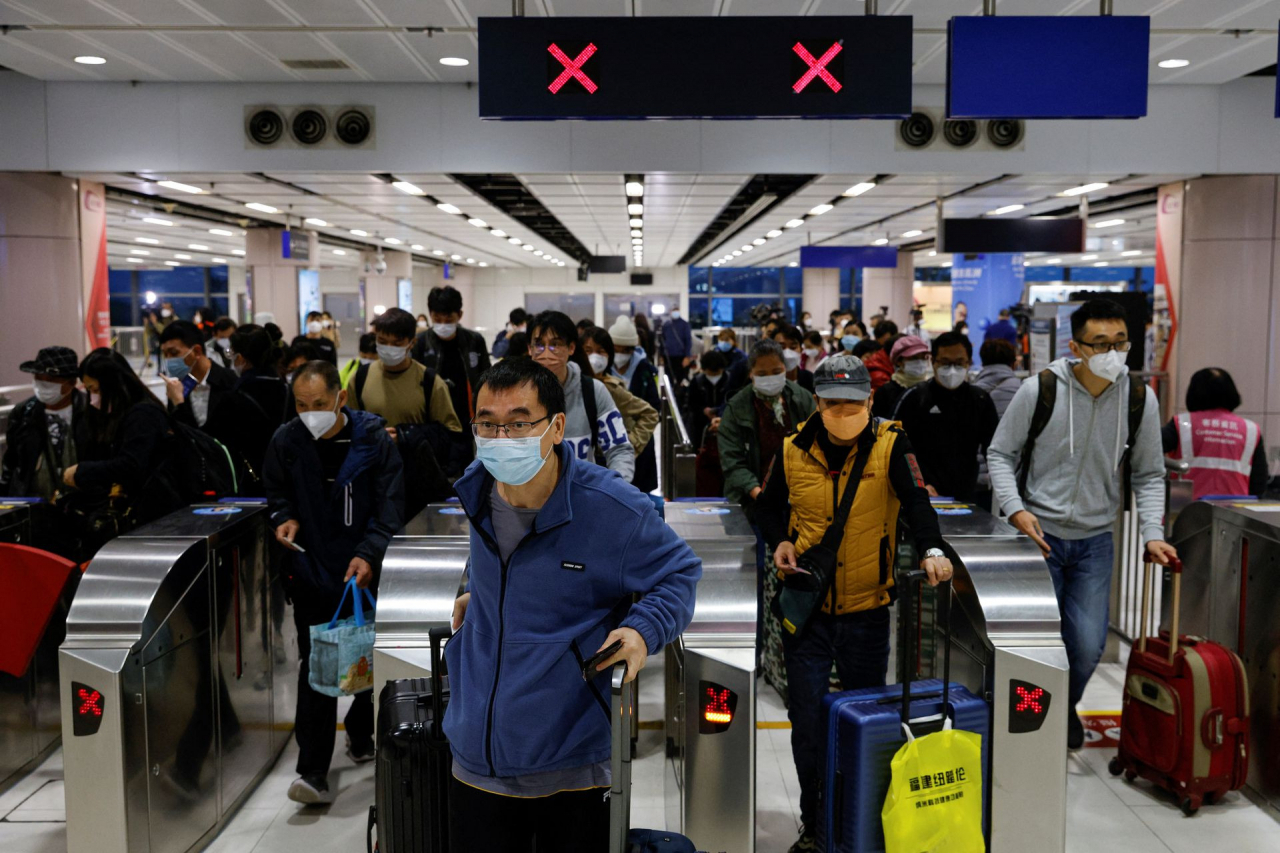 |
Travelers arrive at Hong Kong's Lok Ma Chau border checkpoint on the first day China reopens the border amid the COVID-19 pandemic in Hong Kong, China, Jan. 8. (Reuters) |
With China as its biggest trade partner, South Korea will likely see its economy growth aided by the neighboring country’s reopening of its borders in an easing of the yearslong COVID-19 pandemic restrictions, a Korean trade lobby group said Sunday.
In a report, the Korea International Trade Association said China’s reopening would add 0.16 percentage point to South Korea’s growth rate of 1.6 to 1.7 percent predicted for this year, with the margin making up 10 percent of the growth prospect.
The outlook comes under the premise that China’s easing of its "zero-COVID" policy would add 2.1 percentage points to its growth last year of 3 percent. Under the calculation, China’s reopening would also increase South Korea’s trade volume by 0.55 percentage point this year, KITA said.
China's reopening is predicted to have the biggest impact for Taiwan, which is expected to see its economy grow by 0.26 percentage point from increased exchanges. Vietnam and Singapore will also see their economic growth rates increase, each by 0.21 percentage point, from the reopening.
China’s economic slump has been pointed to as one of the reasons for South Korea’s poor exports last year. According to KITA, the Chinese government's draconian zero-COVID policy caused Korea’s economic growth rate to decline by 0.26 percentage point in 2022.
If China’s economy recovers from the second quarter of this year following the reopening policy, South Korea’s exports would also increase, KITA said.
“Especially with the easing of restrictions and its government’s boost programs, the Chinese economy is expected to begin recovering in the second quarter of this year. Its quarterly economy growth rate is predicted at 6.9 percent in Q2, up 4.3 percentage points from Q1’s 2.6 percent,” KITA said in the report.
With global demand for export goods expected to decline, KITA predicted China would face a trade decrease of 2.7 percent in 2023 compared to the previous year.
Still, the country will be on the recovery track as consumption is expected to increase by 7.3 percent, along with investment and production, which are predicted to go up by 5.5 percent and 5 percent, respectively.
KITA looked into how the increase in China's total demand -- combining annual consumption and investment -- impacts the gross domestic product and exports of its trading countries, and found that 7.6 percent of South Korea's GDP was reliant on China in 2021.
“Korea’s exports have shown a consecutive decline in the past four months. As China is the biggest importer of Korean goods, we should see China’s reopening as an opportunity to expand exports and take actions such as targeting the Chinese domestic market to recover the slump in trade,” said Kang Nae-young, a senior researcher at KITA.
“The country should make efforts to expand exports of consumer goods such as cosmetics and home appliances, as well as intermediary goods including chips, petrochemicals, auto parts and capital goods, to enhance the country’s reputation and also utilize the Regional Comprehensive Economic Partnership,” Kang said.
RCEP is a free trade agreement involving major Asia-Pacific countries and strongly backed by China. The 15 members, which account for about 30 percent of the global GDP, include South Korea, Japan, Indonesia, Malaysia, Australia and China.
The Chinese government gradually abandoned its zero-COVID approach in December. The policies had been in place since the outbreak of the pandemic nearly three years prior.
By Jo He-rim (herim@heraldcorp.com)







![[Today’s K-pop] Blackpink’s Jennie, Lisa invited to Coachella as solo acts](http://res.heraldm.com/phpwas/restmb_idxmake.php?idx=644&simg=/content/image/2024/11/21/20241121050099_0.jpg)